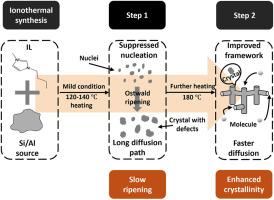A two-step ionothermal synthesis of MFI zeolite framework and its potential applications in adsorption and catalysis
IF 4.7
3区 材料科学
Q1 CHEMISTRY, APPLIED
引用次数: 0
Abstract
This study explores the ionothermal synthesis of MFI-type zeolites using the ionic liquid (IL) [BMIM]Br, with a focus on framework development and functional performance. By tuning synthesis parameters of temperature, Si/Al ratio, and employing a two-step heating strategy, well-crystallized ZSM-5 materials with enhanced porosity were obtained. Structural characterization by XRD, SEM, and N2 physisorption confirmed that the two-step synthesis improved crystallinity and microporosity, while also promoting uniform mesopore formation and better pore accessibility. Functional assessments, including room-temperature N2 adsorption, methylene blue adsorption, and catalytic toluene methylation, were conducted. Using the two-step heating treatment, the N2 adsorption capacity of ionothermally synthesized zeolites increased from 2.57 cm3 g−1 to 3.86 cm3 g−1, and methylene blue adsorption (within 6 h) improved from 61.18 mg/kg to 74.54 mg/kg. Furthermore, toluene conversion rose by 11 %, and xylene selectivity increased by 10 %, confirming the enhanced structural properties achieved through the 2-step heating treatment. Kinetic modeling indicated a shift from diffusion-limited physisorption in single-step samples to chemisorption-driven processes in two-step products. The recyclability of [BMIM]Br was demonstrated after single-step use, but structural degradation occurred following reuse from high-temperature treatments. Comparisons with TPAOH-templated hydrothermal syntheses further highlighted the superior structural direction offered by ILs. These findings advance the understanding of crystal growth in ionothermal systems and emphasize the potential of ILs in tailoring high-performance zeolite materials for catalytic and adsorption applications.

两步离子热合成MFI分子筛骨架及其在吸附和催化方面的潜在应用
本研究探讨了离子液体(IL) [BMIM]Br离子热合成mfi型沸石,重点研究了框架的开发和功能性能。通过调整合成温度、硅铝比等参数,采用两步加热策略,获得了结晶良好、孔隙率提高的ZSM-5材料。通过XRD、SEM和N2物理吸附的结构表征证实,两步合成提高了结晶度和微孔隙度,同时促进了均匀的介孔形成和更好的孔隙可达性。进行了功能评估,包括室温氮气吸附、亚甲基蓝吸附和催化甲苯甲基化。通过两步加热处理,离子热合成的沸石对N2的吸附量由2.57 cm3 g−1提高到3.86 cm3 g−1,对亚甲基蓝的吸附(6 h内)由61.18 mg/kg提高到74.54 mg/kg。此外,甲苯转化率提高了11%,二甲苯选择性提高了10%,证实了通过两步加热处理获得的增强的结构性能。动力学模型表明,从扩散限制的单步样品物理吸附到两步产品的化学吸附驱动过程的转变。[BMIM]Br在单步使用后具有可回收性,但在高温处理后重复使用会发生结构降解。与tpaoh模板水热合成的比较进一步突出了ILs提供的优越结构方向。这些发现促进了对离子热系统中晶体生长的理解,并强调了离子热在定制用于催化和吸附应用的高性能沸石材料方面的潜力。
本文章由计算机程序翻译,如有差异,请以英文原文为准。
求助全文
约1分钟内获得全文
求助全文
来源期刊

Microporous and Mesoporous Materials
化学-材料科学:综合
CiteScore
10.70
自引率
5.80%
发文量
649
审稿时长
26 days
期刊介绍:
Microporous and Mesoporous Materials covers novel and significant aspects of porous solids classified as either microporous (pore size up to 2 nm) or mesoporous (pore size 2 to 50 nm). The porosity should have a specific impact on the material properties or application. Typical examples are zeolites and zeolite-like materials, pillared materials, clathrasils and clathrates, carbon molecular sieves, ordered mesoporous materials, organic/inorganic porous hybrid materials, or porous metal oxides. Both natural and synthetic porous materials are within the scope of the journal.
Topics which are particularly of interest include:
All aspects of natural microporous and mesoporous solids
The synthesis of crystalline or amorphous porous materials
The physico-chemical characterization of microporous and mesoporous solids, especially spectroscopic and microscopic
The modification of microporous and mesoporous solids, for example by ion exchange or solid-state reactions
All topics related to diffusion of mobile species in the pores of microporous and mesoporous materials
Adsorption (and other separation techniques) using microporous or mesoporous adsorbents
Catalysis by microporous and mesoporous materials
Host/guest interactions
Theoretical chemistry and modelling of host/guest interactions
All topics related to the application of microporous and mesoporous materials in industrial catalysis, separation technology, environmental protection, electrochemistry, membranes, sensors, optical devices, etc.
 求助内容:
求助内容: 应助结果提醒方式:
应助结果提醒方式:


